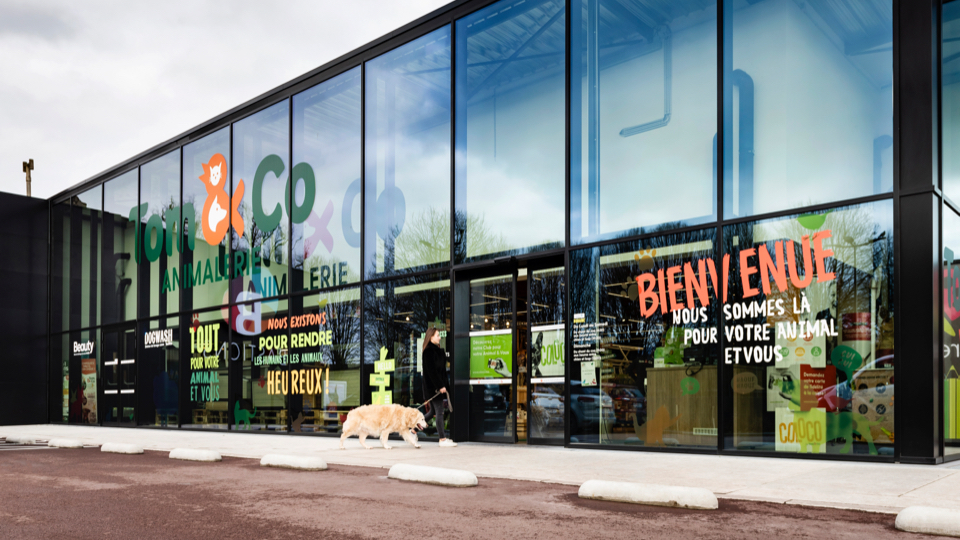The path to differentiation for Belgian retailer Tom&Co

Finding the right retail concept for each individual market is set to be the key to future growth at Tom&Co.
Tom&Co has a chain of pet stores across Belgium, France and Luxembourg. Its strategy is based on growth via organic expansion, acquisition and differentiation.
At present, the company has 175 stores trading across the 3 countries. It is already a market leader in Belgium, where the brand is well known and popular. It intends to capitalize on that brand awareness, and develop it elsewhere by identifying the right concept for each market.
Store differentiation
Maud Leschevin, Chief Operating Officer, gives an indication of Tom&Co’s ambition: “to increase the number of shops to 250 by 2026”. Much of this growth will take place in France, where the company plans to buy smaller chains and to open around 10 new stores every year. In Belgium, 2 new stores will be opened each year, mainly in the Flemish region, while existing stores will be remodeled.
Leschevin says: “We are trying to grow organically in different stores in the same region. We see several opportunities in the way we operate. For example, by taking one destination store, and testing more of them as well as more service stores, with some differentiation between them.” Tom&Co is planning to roll out destination stores based in retail parks where there is a large assortment of products and services, along with franchising stores. This enables it to adapt its stores to local needs and customer requirements, as well as to motivate retail teams.
Brick-and-mortar vs online
Tom&Co currently has a top position in the traditional store sector, but has not yet achieved that online. The company began developing an omnichannel strategy 2 years ago and aims to accelerate this during 2022. “We are going to become more aggressive online in both food and non-food,” states Maud Leschevin.
A click&collect system will be implemented by the end of 2022, as well as a 2-hour same-day home delivery service, either from a store – if the product is available – or from the central warehouse. These omnichannel services will evolve gradually, depending on the market, with home delivery from the warehouse set to reach 10% by 2026.
Store involvement will remain crucial, as Leschevin explains: “We don’t want to cannibalize sales from our stores to online. A large part will still be via the stores, using convenient digital solutions like click&collect.”
Double-digit growth
Tom&Co has experienced double-digit growth over the past 3 years. Sales have been increasing steadily. 2021 proved to be a record year, with more than €260 million ($295M) in revenue, and a 10% increase in sales.
Leschevin says that this growth comes from a 6% increase in transactions and a 3% increase in basket size. Customers have been buying 6% more products, although at a slightly lower price point.
This was particularly evident over the Christmas period, when sales of toys and snacks increased, but sales of higher-priced cushions slowed down. In Belgium, the market is growing both in terms of volume and value, with pet specialty stores taking a greater share of sales from grocery stores. Much of this growth is being fueled by an increase in the number of pets per household, as well as in demand for the quality product ranges which can be obtained from specialist pet outlets.
Customer-focused products
In terms of the product range on offer, Tom&Co analyzes the customer platform carefully to identify what people are looking for, and then develops suitable products and services. Exclusive private labels are being used to adopt a much more segmented approach, rather than copycat brands offering better prices.
The company has developed 5 private label brands, either in-house or via an exclusivity agreement with small market brands. This covers 7,000 products in all. One of the more unusual market sectors to be identified was the insect market.
Leschevin comments: “This is a small market, but we have a new private insect label through an exclusive agreement.” The intention is to test the waters in the market, but Tom&Co is not likely to launch an own brand for this kind of food within the next 2 years.
Looking at other product ranges, Tom&Co believes that consumers are ready to pay more for quality, since they are conscious of the impact good-quality food has on their pets. One example of this is increased demand from Belgian consumers for specific products to tackle obesity and other health-related issues. Consumers are also seeking greater transparency about the degree of local sourcing, together with information on the amount of sugar and meat in a product. This emphasis on local origin has been a key trend for the past 2 years, as the pressures of COVID-19 led to consumers wanting to buy products sourced within their own country.
Retail concept for the future
As to the future, Tom&Co intends to prioritize its focus on natural, premium and functional foods, plus the provision of vet services within stores, to create a more differentiated offer. The intention is to offer a complete service based on value, pet well-being and advice, with well-trained staff who can sell higher-priced products. This is a retail proposition that needs to continually evolve, while adapting to local needs. It will focus in particular on growth within France on a regional basis.
Having proved its resilience over the past 2 years, Tom&Co believes it has a recipe for long-term success. Its ambition is to create a concept tailored to the consumer and the local market, combining both store-based retail and online to build a comprehensive omni-channel retail business.
